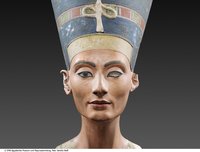Die auf der Seite liegende Kuh stammt aus einem größeren Modell, das eine vollständige Schlachtungsszene mit mehreren Akteuren zeigte. Das Motiv der Rinderschlachtung ist in den Grabdarstellungen des Alten Reiches (2700–2150 v. Chr.) sowie in den Modellen des Mittleren Reiches weit verbreitet, denn dadurch wurde die ewige Versorgung des Verstorbenen gewährleistet. Durch das Zusammenbinden eines Vorder- und eines Hinterbeines ist das Tier auf die Seite gefallen. Die rote Farbspur am Hals deutet an, dass dem Rind bereits mit einem scharfen Messer die Halsschlagader durchtrennt worden ist.
(O. Zorn)
en

